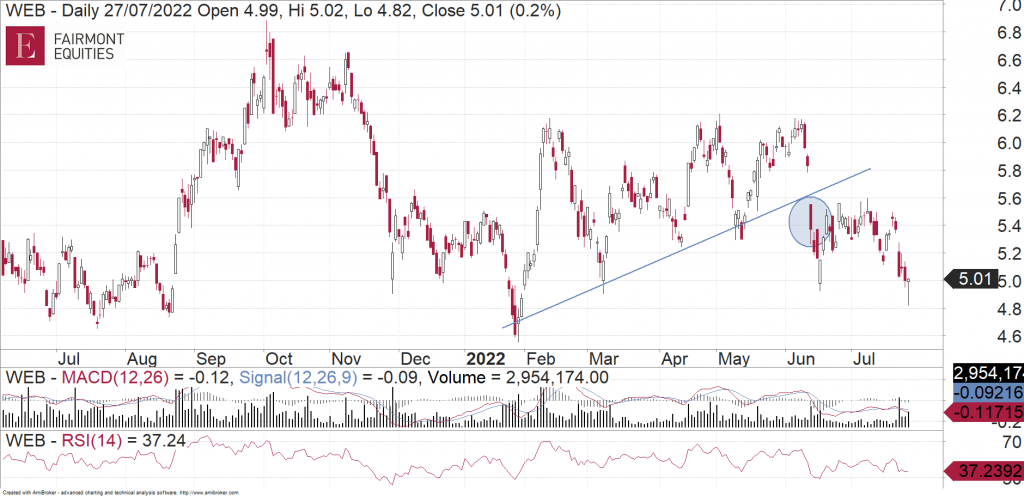Following a global de-rating of shares in the travel sector on macroeconomic concerns, the stronger-than-expected recovery in demand raises the question as to whether travel stocks, such as Webjet (ASX:WEB), present an attractive opportunity. While Webjet’s share price performance this year has been patchy, we recently researched the Company to see if there are any catalysts for re-rating.
About Webjet
Webjet has two key business units – Business to Consumer (B2C) and Business to Business (B2B). The B2C business consists of Webjet Online Travel Agency (OTA) which is Australia’s number one online travel agency and GoSee (formerly Online Republic), which is a consolidated marketplace for car and motorhome rentals worldwide. 
The Company’s B2B business, WebBeds, is the world’s 2nd largest and fastest growing accommodation supplier to the travel industry. WebBeds acts as an intermediary between hotels looking to fill hotel rooms and its clients looking to find rooms for their customers. The global B2B market is valued at A$70b and WebBeds, as at FY22, had a market share of ~4%. WebBeds operates globally and reports under four regions: Europe; Americas, Middle East & Africa; APAC; and Umrah Holidays. Since establishing WebBeds in 2013, the Company has scaled the B2B segment via both organic and acquisitive growth.
Key Fundamental Drivers
Important Metrics Continue to Recover
Trading for the current quarter (1Q23) is currently tracking well ahead of 4Q22, in terms of key metrics such as Average Booking Value, Total Transaction Value (TTV), revenue and earnings (at the EBITDA level). More recently, a trading update by ASX-listed Company Flight Centre Travel Group has pointed to a continues acceleration of TTV. This has been driven by both an uplift in demand and higher than normal ticket prices linked to a lack of airline capacity, particularly on international routes.
WebBeds (B2B): Significant Earnings Upside Over Medium Term
The Company expects month-on-month growth in its WebBeds business in 1Q23 and into 2Q23. This expectation is in line with the upbeat commentary from travel companies across Europe and North America that the current northern hemisphere summer holiday period will be the best in recent years.
WebBeds is well placed to materially increase its market share (was 4% pre-COVID) as activity recovers and it aspires to be the largest player in the B2B market (currently #2). Management has an aspirational TTV target of A$10b, which would give the Company a future market share of 14%.
As at FY22, TTV was $1.1b and below the previous (pre-COVID) high of $2.6b in calendar year 2019. WEB intends to increase its market share by expanding into new regions (greater focus on domestic travel, particularly in the Americas) serving new customers (airlines, super apps, travel apps/sites and loyalty) and taking advantage of changing travel patterns post COVID.
WebBeds’ future profitability target remains ‘8/3/5’ or 8% revenue/TTV margin, 3% costs/TTV to deliver 5% EBITDA/TTV margin. This implies an EBITDA margin target of 62.5%, up from an 11% EBITDA margin in 2H22. The Company expect that this EBITDA margin target would not be achieved until 2H24.
If the Company were to achieve an increase in TTV to pre-COVID levels ($2.6b) over the medium term, this would equate to EBITDA of A$130m for WebBeds (i.e. TTV of $2.6b x revenue margin of 8% x EBITDA Margin of 62.5%). In context, WebBeds generated EBITDA of $5.8m in 2H22.
Webjet OTA: Earnings Growth Hampered by Higher Operating Costs
As at May 2022, bookings were tracking at ~80% of pre-COVID levels and the Webjet brand has continued to extend its lead as the #1 Online Travel Agent in Australia & NZ. Market share has increased to 12.7% of domestic bookings and 10% of all travel agency bookings (offline and online), compared to 9.3% and 5.6%, respectively, in 2019.
There is an opportunity for further improvement in bookings (i.e. relative to pre-COVID levels) as international travel recovers. However, this is reliant on airlines matching inbound travel demand with outbound travel demand. At present, the mismatch between the two is resulting in elevated ticket prices and flight schedules to normalise. It is worth noting that the OTA’s international sales are about 15% of booking volume but ~45% of revenue/EBITDA given higher booking fees and overrides. Further, international travel not only has a higher Average Booking Value, but also has higher ancillary revenue streams attached.
While EBITDA margin is expected to improve, and notwithstanding that the B2C business has a highly scalable cost base (where approximately 80% of expenses are variable and able to be scaled in line with demand); the prospect of increasing operating costs is hampering the EBITDA growth trajectory out to FY25. In particular, the Company is increasing its investment in technology across the business in order to enhance its market positioning and build a clear competitive advantage by being the lowest cost provider.
Net Cash Balance Sheet Position to Increase Further
The balance sheet had a net cash balance of $108m as at 31 March 2022, which is above the average net cash position held since FY11. The net cash balance is expected to increase further in FY23 and FY24 given that operating cashflow has improved substantially.
The strong net cash position enables the Company to pursue any value-accretive opportunities and would enable WEB to resume dividend payments from the final dividend of FY23. Further, debt expiry risk is minimal, as all the group’s term debt (A$86.7m) is not due until November 2023.
Fundamental View
On a FY24 P/E basis, the shares are trading on a multiple of 16x, which compares to an average 1-year forward P/E multiple of ~19x over the three years prior to COVID-19.
We consider WEB’s key fundamental attractions to be: i) The potential for medium-term earnings expansion for WebBeds segment (which is the larger contributor to earnings), ii) A strong balance sheet which enables Merger & Acquisition opportunities and/or further investment in technology and iii) Market leadership position in both the WebBeds and Webjet OTA segments.
Notwithstanding the attractive fundamentals, we take a cautious view on the shares at current levels, as we expect the shares to continue trading at a discount to the average 1-year forward P/E multiple over the three years prior to COVID-19, given that key measures such as TTV and EBITDA margin are still recovering. In turn, this is clouding earnings visibility for FY23.
Charting View
Since late January, WEB had been trending higher and also forming resistance up near $6.20. In mid-June however, it failed to break to the upside. Instead, it broke to the downside (circled). It then crept higher and tested the underneath of the old diagonal support line. It is now turning back around here and heading south again. At this point in time it looks like WEB shares can head lower from here.

Michael Gable is managing director of Fairmont Equities.
Current share prices available here.
You can learn more about technical analysis in this article.
An 8-week FREE TRIAL to The Dynamic Investor can be found HERE.
Would you like us to call you when we have a great idea? Check out our services.
Disclaimer: The information in this article is general advice only. Read our full disclaimer HERE.
Like this article? Share it now on Facebook and Twitter!

